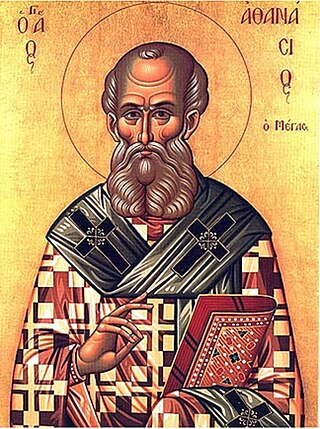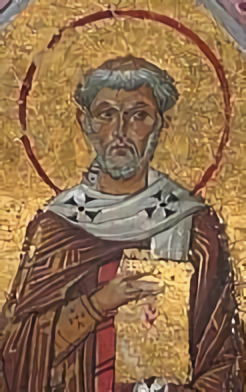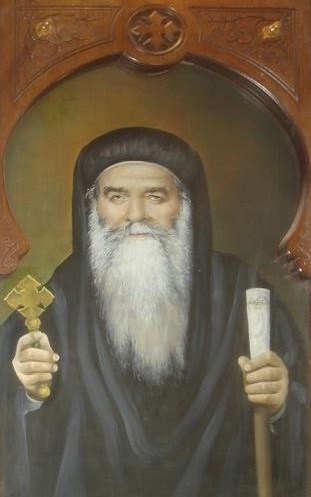
Athanasius I of Alexandria, also called Athanasius the Great, Athanasius the Confessor, or, among Coptic Christians, Athanasius the Apostolic, was a church father and the 20th pope of Alexandria. His intermittent episcopacy spanned 45 years, of which over 17 encompassed five exiles, when he was replaced on the order of four different Roman emperors. Athanasius was a Christian theologian, a Church Father, the chief defender of Trinitarianism against Arianism, and a noted Egyptian Christian leader of the fourth century.

Pope Leo I, also known as Leo the Great, was Bishop of Rome from 29 September 440 until his death.

This article uses dates and years written in the Coptic calendar, using the A.M. calendar era, in addition to the Gregorian calendar, using the A.D. calendar era.
Pope Alexander II of Alexandria was the 43rd Pope of Alexandria and Patriarch of the See of St. Mark.
Pope Theonas of Alexandria was the 16th Pope and Patriarch of Alexandria, reigning from 282 to 300.

Damian of Alexandria was the Coptic pope and patriarch of Alexandria from 576.
Saint Joseph I of Alexandria (Abba Yousab), 52nd Pope of Alexandria and Patriarch of the See of St. Mark.

Pope Cyril V of Alexandria (Abba Kyrillos V), 112th Pope of Alexandria & Patriarch of the See of St. Mark for 52 years, 9 months and 6 days. He was the longest-serving Pope in the history of the Coptic Orthodox Church. He was born as Youhanna (John) in 1824 or 1830/1831 according to different accounts and he died on 7 August 1927.
Pope Benjamin II of Alexandria, 82nd Pope of Alexandria and Patriarch of the See of St. Mark. His episcopate lasted for eleven years, seven months and 26 days from 10 May 1327 to 6 January 1339.
Pope John IV of Alexandria, 48th Pope of Alexandria and Patriarch of the See of St. Mark.
Pope Simeon II of Alexandria, 51st Pope of Alexandria and Patriarch of the See of St. Mark.
Pope Matthew III of Alexandria was the 100th Pope of Alexandria and Patriarch of the See of St. Mark. His papacy was during the time when Egypt was part of the Ottoman Empire and was ruled by consecutive short-term representatives of the sultan and the church was under much pressure from the rulers.
Cyrus of Alexandria was a Melchite patriarch of the see of Alexandria in the 7th century, one of the originators of monothelitism and the last Byzantine prefect of Egypt. He died in Alexandria on March 21, 642.
The Scythian monks were a community of monks from the region around the mouths of the Danube, who played an influential role in Christian theological disputes between the 4th and 6th centuries. The name Scythian comes from Scythia Minor, the classical name of the modern Dobruja region in Romania and Bulgaria, at the time a Roman province. The monks were raised not only from local Christian elements, but also from immigrant Christians who came to live ascetic lives.
Pope John II (III) of Alexandria, was the 30th Pope of Alexandria & Patriarch of the See of St. Mark.

The Monastery of Saint Anthony is a Coptic Orthodox monastery standing in an oasis in the Eastern Desert of Egypt, in the southern part of the Suez Governorate. Hidden deep in the Red Sea Mountains, it is located 334 km (208 mi) southeast of Cairo. The Monastery of Saint Anthony was established by the followers of Saint Anthony, who is the first Christian monk. The Monastery of St. Anthony is one of the most prominent monasteries in Egypt and has strongly influenced the formation of several Coptic institutions, and has promoted monasticism in general. Several patriarchs have come from the monastery, and several hundred pilgrims visit it each day.

Coptic history is the part of the history of Egypt that begins with the introduction of Christianity in Egypt in the 1st century AD during the Roman period, and covers the history of the Copts to the present day. Many of the historic items related to Coptic Christianity are on display in many museums around the world and a large number is in the Coptic Museum in Coptic Cairo.
Saint Misael the Anchorite was a Christian monk who is venerated by the Coptic Orthodox Church.

Monastery of Saint Samuel the Confessor, Dair al-Anba Ṣamū'īl al-mu'tarif " or Deir el-Qalamun is an Egyptian monastery in the Western Desert.







